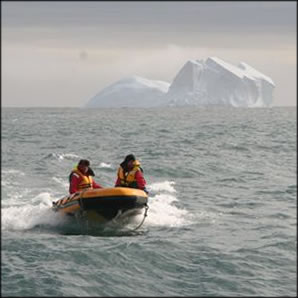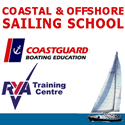It has been the biggest year to date and top of the list was our 5 week trip to the Balleny Islands at 66 degrees 50 minutes south. They are on the NW corner of the Ross Sea, mainland Antarctica and 1,200 miles due south of New Zealand.
A charter for the New Zealand Ministry of Fisheries, doing an underwater dive survey of the coastline; bird and seal counts, as well as taking biopsy samples of humpback whales.
I just wished that they had picked a different part of the Antarctic to go to. The Balleny Islands have the distinguished reputation of being a hard place to reach and an even harder place to do work.
 Before we left I spent large amounts of time looking at ice charts and consulting with ice experts, skippers and weather experts. Most of them agreed that it was a bold but feasible plan. There were a few notable exceptions remarking I was a braver man than them to go there in such a small vessel. Of course one gets a bit worried about these sorts of remarks from knowledgeable people, but after analyzing and discussing all the various points of view I felt that it was possible to do it within acceptable safety parameters
Before we left I spent large amounts of time looking at ice charts and consulting with ice experts, skippers and weather experts. Most of them agreed that it was a bold but feasible plan. There were a few notable exceptions remarking I was a braver man than them to go there in such a small vessel. Of course one gets a bit worried about these sorts of remarks from knowledgeable people, but after analyzing and discussing all the various points of view I felt that it was possible to do it within acceptable safety parameters
The island group is very, very remote, rarely visited and locked in the ice for about 10 months of the year. The west coast of the island group is only ice free for about one month of the year and sometimes it does not get free of the pack ice at all.
No small boat had been to the Balleny islands since David Lewis visited them briefly 28 years ago on Solo. The island group is situated in the friction zone between the permanent Antarctica high and southern ocean lows.
During our southbound voyage we had favorable westerly to north westerly winds 35 to 45 knots. Tiama loves this sort of breeze lapping it up under storm tri-sail and hurricane jib with a drop of Genoa rolled out when needed. For this voyage I fitted a very small jib on the inner forestay. This was a tiny bit of rag built like a brick shit house and a beautiful thing to have in a stiff breeze.
The day we arrived it was flat calm with 3 humpback whales on the port bow. Work began immediately photographing their flukes for later identification and taking biopsy samples. On that first day we got several good fluke shots and one biopsy sample which was a good start for the science program.
This was real scientific whaling, unlike the slaughter that was taking place 2000 miles due east by the so called scientific Japanese whaling ships. It was good to know that my old Greenpeace colleagues were there at the same time trying to stop them.
We managed to carry out 90 % of the scientific program, which was a bit ambitious to start with. The 4 scientists onboard worked hard, doing on average 2 dives a day in minus 1.5 degree waters, ice all around, and chilly just to watch. It was cold enough for the fresh water tanks on board to start freezing up.
The weather gods treated us kindly for this expedtion, and although all the historic records of the Balleny islands state that there is no shelter for boats, we managed to find shelter where previously nobody had found any. I think this was mainly due to the different view seen through the eyes of a small boat skipper compared to the view from the bridge of a big ship. We can turn around on a penny, have a lifting keel that can reduce our draft from three meters to 1.2 meters in a few minutes and can find shelter in shallow waters behind cliffs, sand spits and islands.
Most of the better places to park for the night were close to the partly ice free Capes of the bigger islands or on the sides of the smaller islands that had more gently sloping hills and lower cliffs. Here we could get close in and find bottom without the threat of a house sized lump of ice landing on the deck. Unfortunately none of the anchorages that we found allowed for the luxury of the whole crew sitting down below over a glass of wine. We always had to have one person on worry duty topsides.
The North Eastern Cape of Buckle Island was by far the worst place that we used. Anchoring in 80 meters of water with 120 meters of chain out is not really anchoring. It is more like having a small precarious foot hold. This foothold was accompanied by an active calving glacier 600 meters away, which sent regular small rivers of ice our way, bumping and scraping along the hull, which you can imagine meant none of us slept well that night.
For the trip back up north we had not so favorable west to North West winds, 3 big systems came through peaking at 55 knots each. Tiama is just a great deep sea boat, beautiful to watch as she works her way through the water, scary at times for sure, but just right.
We arrived back in Bluff March 5th, after 5 weeks at sea, with only a few minor cases of cabin fever onboard. I’m happy to report that we did not break much gear. In fact I only spent $150 in the hardware shop to replace a few lost and broken items. This is less then what we break on our regular NZ Sub-Antarctic trips.
I know that one needs drama to make a good story, so be assured the trip did make my hair go a bit greyer. Our contact at the Ministry of Fisheries asked on our return if we wanted to do another trip. I agreed to do so but suggested that we should have a year break in between to give the skipper a chance to catch his breath and put his feet by the fire at home.
We did another refit on Tiama before this expedtion and she is now fitted out with dive compressor, dive bottles etc for remote expedition dive work; a top of the range depth sounder which can record up to 700 meters and log depths, course, position, barometric pressure etc in a spread sheet form…. very fancy gear.
The remainder of the southern summer season was spent sailing to the NZ Sub Antarctic islands supporting various research programs. One notable trip was collecting mushrooms for an American university sponsored by National Geographic with a weird, wonderful and eccentric bunch of scientists onboard. But nothing quite as exciting as the Balleny islands.
For the winter months we are back in Auckland doing maintenance work etc. Looks like next summer we will be working again from the Port of Bluff sailing to the NZ sub Antarctic islands.
Tiama and her crew are well, Ruby has gotten her first commercial boat operator’s certificate, and occasionally sails as mate onboard Tiama. Bunny is desk bound at Greenpeace New Zealand. And I’m floating about as happy as ever.
Kind regards
Henk

